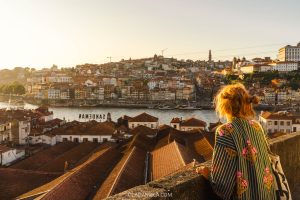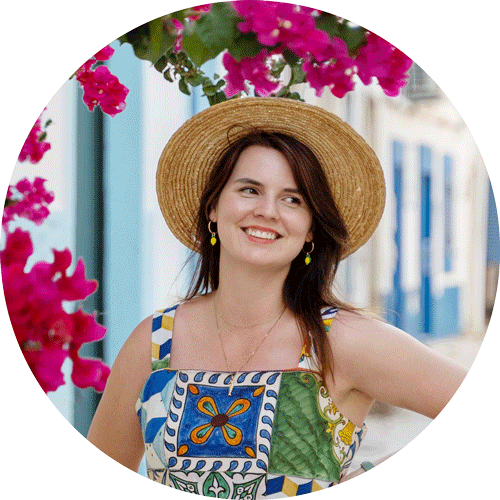Updated Feb 19, 2025
The strong sound of jangling cowbells on a crisp winter evening is forever etched in my memory. Now just hearing the distinct clanging raises my heartbeat, taking me back to a few dark and wild nights in the remote north-west of Portugal, when I was traipsing about Podence trying to avoid encounters with the local caretos.
Every February the streets of a few small Portuguese villages come alive with dark winter carnivals, known in Portugal as entrudos. These pre-Lent or Shrovetide festivals were a chance for the locals to forego society’s rules for just a moment. By concealing their identity with huge masks and crazy costumes, their mischievous side bubbles to the surface.
Yes, the devil is on the loose in Portugal, so watch your back.


To this day, men in a handful of ancient villages continue the bizarre traditions of their ancestors. To the sound of beating of drums and the squeal of a gaita, masked caretos or foliões run amuck, causing ~mostly~ harmless fun and poking fun at their neighbours.
While Portugal has more modern Carnival celebrations – like those in Rio de Janeiro with glitter, floats and smiles from ear-to-ear – I certainly find myself drawn to the darker side where you never what chaos lies around the next stone-walled village corner.
Below I’ve rounded up the eight best traditional Portuguese Carnivals. These tend to celebrate the changing of seasons with fire, feasting, and fanfare in the name of spring fertility. Usually the fun runs from the Saturday until Shrove Tuesday.
I’ve also included a handful of the bigger and more popular modern carnival parades at the very bottom.
Contents
ToggleWhat is an entrudo?
This is an ancient carnival tradition held every February or March, usually on Fat Sunday or Shrove Tuesday – the days before Lent. Most festivities happen in small villages in the north or centre of Portugal. It’s a time to celebrate the end of a long, dark winter and perform rituals to stimulate fertility – both for a good harvest and for women.
These mischievous parties and carnivals scare off evil energies and bring together the community. You can expect costumes, masks, and odd traditions or rituals. The origins of entrudos are unknown, but some scholars link it back to Roman times, and others to ancient Neolithic roots.
Many of these festivities have been reborn after a severe depopulation of rural villages, starting in the 1960s. During these celebrations many young people now return to their villages to continue the tradition and keep it alive.
In 2025 Shrove Tuesday falls on March 4. In 2026 it will be February 17.
Cowbells, chaos & candle-lit processions: Entrudo Chocalheiro
Where: Podence, Bragança, Trás-os-Montes, North Portugal



Grasping tall, red, wax-dipped torches, we follow a pagan parade through the usually quiet Tras-os-Montes village of Podence. Arriving at an open field, the hooded caretos – dressed in a fringed red, yellow and green suit and deep red metal mask – start to leap anticlockwise around a dry hay effigy of themselves. The heavy cowbells hanging from their belts clanging violently in the breeze.
Within seconds, flames engulf the haystack, sending a heatwave through the crowd. The long, cold winter is over, but the Entrudo Chocalheiro, an ancient four-day carnival in Portugal’s remote Tras-os-Montes region, has just begun.
Each February, ancient pagan rituals invade this sleepy stone village for four days of feasting, fire and fanfare. The UNESCO-protected Entrudo Chocalheiro is a devilish ritual dating back more than 2,000 years. Wearing the “devil’s skin”, local men skip about lawlessly looking to cause mischief and shake their cowbells at random women in the name of spring fertility.
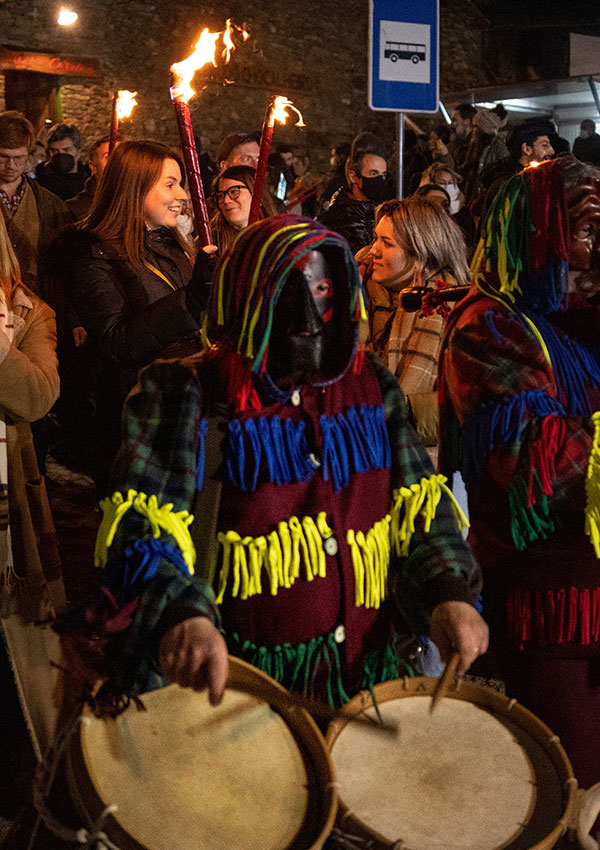
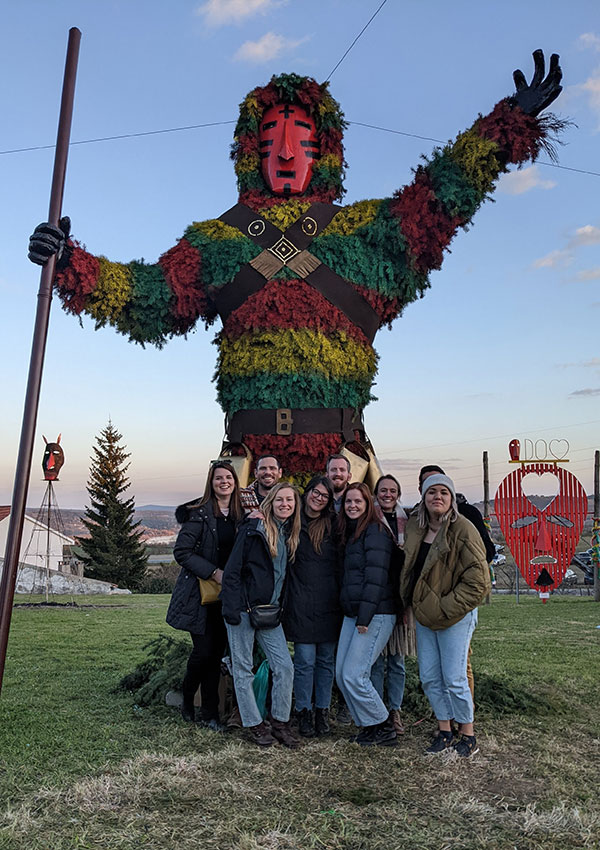
Getting there: Podence is a small village about one hour and 45 minutes from Porto, or 4.5 hours from Lisbon. If you don’t have a car, the closest large town is Macedo de Cavaleiros, and you can take a direct bus there from Porto and then a 15-minute taxi. Alternatively, there’s an irregular local bus that moves between Macedo and Podence.
Where to stay: Podence, ideally. It’s a tiny village (that finally has an ATM!). If you can’t find accommodation in Podence, I highly recommend the lake-side village of Santa Combinha. It’s on a peninsula in a natural park on the shores of Azibo Lake. It was the most gorgeous spot to wake up in each day.
Cork masks, a village rally & plenty of wine: Entrudo of Aldeias de Xisto de Góis
Where: Aigra Nova, Aldeias de Xisto de Góis, Coimbra, Central Portugal


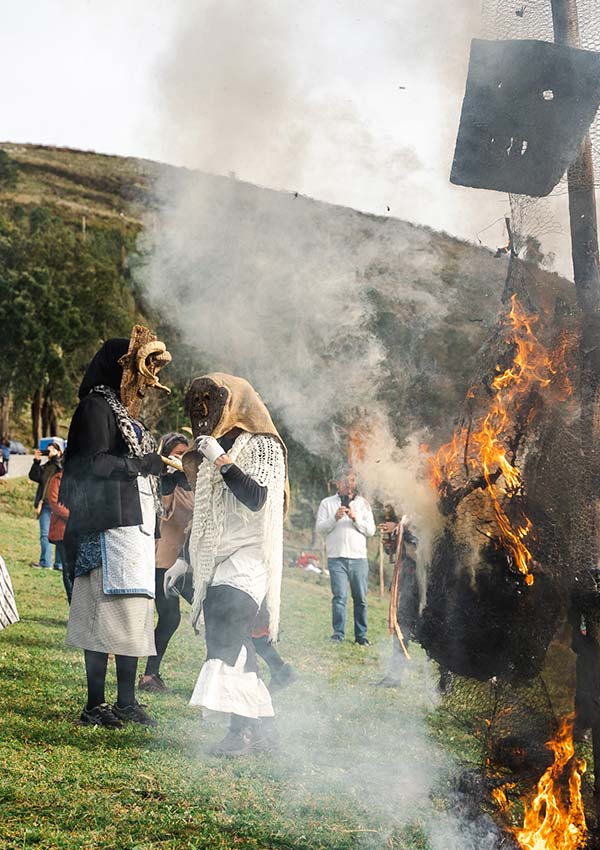
We arrive before 8.30am on a sunny winter Sunday to find the streets of Aigra Nova buzzing. A stream of villagers starts rolling down a steep cobbled street towards us. Men dressed in women’s clothing, women dressed as men. Many have underwear on the outside, or bras stuffed with oranges. All are wearing homemade masks made of raw cork bark, embellished with horns, moss and other natural features.
We pile into a mini bus and set off on a chaotic “rally” to four other schist villages before returning to Aigra Nova for lunch, dancing and to burn a pagan effigy. Hell yes! The price for transport and the multi-course lunch with wine? €11 in 2023 – email ahead to book a spot.
About 2.5 hours north of Lisbon lies a handful of quaint Schist Villages (Aldeias de Xisto) of Góis. There’s a problem with these remote, hard-to-reach stone villages – they’ve been slowly depopulating. Almost two decades ago the area restarted old carnival traditions based on interviews with elderly residents to bring back some of the magic, chaos and charm of the old days.
Full event run-down: The traditional entrudo carnival of the Schist Villages
Getting there: Aigra Nova is a one-person Schist Village, around 2.5-hours from Lisbon and two hours from Porto. If you don’t have a car, the most efficient journey is a train to Coimbra then a 50-minute taxi. Alternatively, you could take a local bus from Coimbra to Lousã, then a 20-minute taxi to the remote village.
Where to stay: Aigra Nova is very, very small. We stayed at a small and humble guesthouse, Casa D’Avó Mila, in the village of Vila Nova do Ceira, which was close enough to the action. You could also try hotels in Goís, which is the biggest town of the area. We only stayed one night and drove home to Lisbon after the Sunday fun.

Wooden masks, hay suits & bells: Entrudo de Lazarim
Where: Lazarim, Douro Valley, North Portugal


Each whimsical wooden mask is carved from a single tree trunk, with every person attempting to outdo the next. These heavy masks give the wearer anonymity, something that links all traditional Portuguese entrudos. In Lazarim rest of the outfit might be a big hay suit, or shaggy hessian sacks, or natural objects sewn into a suit. The goal is to hide your true self so you can run amuck and cause light-hearted trouble without being caught.
I went to this entrudo in 2024 on Shrove Tuesday and had a blast. After the reading of wills by the Comadre and Compadre, the fire is lit, the effigy burns (with fireworks!) and then the feast begins! We’d seen steaming iron cauldrons of feijoada (a hearty bean and meat stew) and caldo de farinha (a corn flour soup with cabbage and smoked meats) cook over open fires all afternoon, and finally got to tuck in. By 6pm most had gone home, but my girlfriends and I found ourselves in what felt like the only tiny bar, eating bifanas (pork sandwiches) and dancing to an accordian.

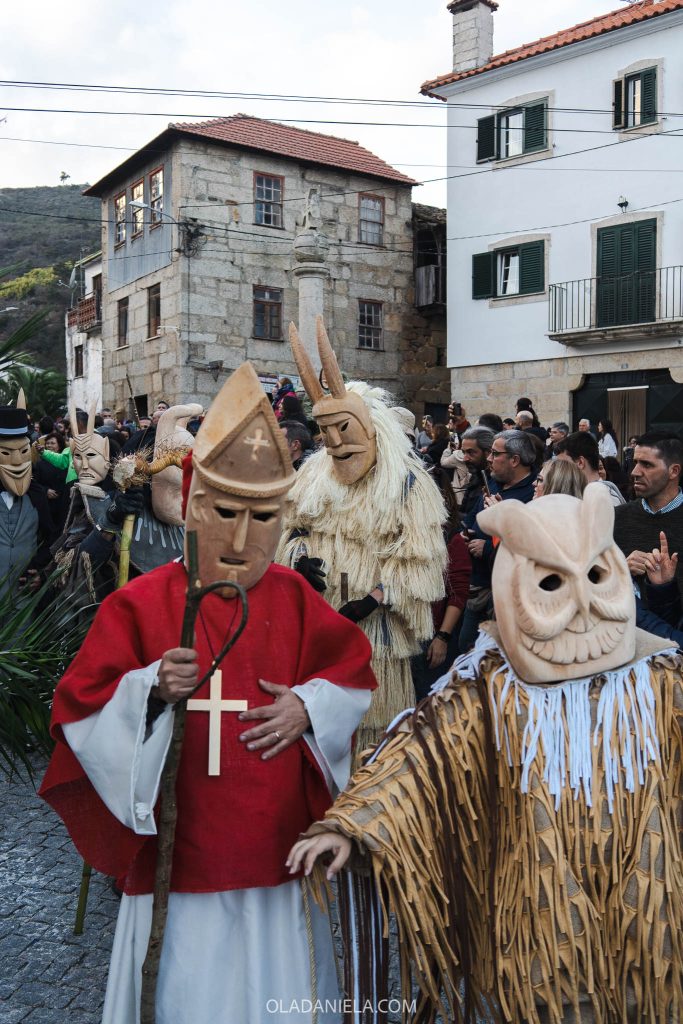

Getting there: Lazarim is a small village south of the Douro River. It’s a 90-minute drive from Porto, or a 3.5-hour drive from Lisbon. There’s a direct bus from Porto and from Lisbon with Rede Expressos to Lamego. Then you’ll need to take a 20-minute taxi. You can also take the train to Resende and then a 30-minute taxi.
Where to stay: As a rural village, there isn’t a lot of accommodation so book your guesthouse ahead or stay in nearby Lamego.
Read next: 16 most beautiful villages and small towns in Portugal
Sheepskin, screams & streamers: Carnaval de Vale de Ílhavo
Where: Ílhavo, Aveiro, Central Portugal

“Cardadores” take to the streets of Vale de Ílhavo in wild and wonderful bird-like costumes. As they run, bells rattle and colourful headdress flow majestically in the breeze. Groups of local single men craft their own costumes, with masks made from white sheepskin with red-painted cork around the eyes and mouth. Their head is covered by long flowing coloured ribbons, the moustache is made from horse or ox hair, and the pièce de résistance is a long and phallic red nose made from red cloth.
As part of this carnival character, the young men learn some specific dances and howls, and with their identities hidden they go out to “card” girls. They carry carding paddles – the traditional tool you’d use to prepare fibres like wool or linen to be spun into fabric. The Cardadores run through the crowds, causing a ruckus with whistles and bells, leaps and bounds, look for ladies (or, more recently, men too) ripe for this ritual. It sounds like the carding paddles used to have spikes, but now Cardadores only have sandpaper (thank goodness).
I went in 2024 on Fat Sunday and it was super fun to experience. This carnival is really small – tiny, actually – and the majority of the 3pm parade is more modern with floats of kids, drum lines and community groups adding up to around 400 people. The Cardadores came through at the start in a flurry of activity and noise. We were able to loop around and catch them a second time. This town is fmous for its bread, so try the chorizo bread baked in the bakery on wheels that went by! After, there wasn’t much to do but Aveiro is nearby.

Getting there: This carnival is one of the most accessible. It’s just a 15-minute drive south of Aveiro, Portugal’s sixth-largest city and a fun university town. It’s one hour south of Porto, and 2.5 from Lisbon. If you don’t have a car, it’s easy to take a train to Aveiro – or a slower service might stop at Quintas station, which is marginally closer.
Where to stay: Vale Ilhavo is so close to Aveiro and you can find great hotels and guesthouses in the small city, like Up Sal.
Flames, feasting & false marriages: Entrudo de Vila Boa de Ousilhão
Where: Vila Boa de Ousilhão, Vinhais, Trás-os-Montes, North Portugal
Podence might be best known for its caretos but it’s not the only Trás-os-Montes village with a similar pre-Roman ritual. In Vila Boa de Ousilhão, a further 36 kilometres north of Podence, the remote Vinhais village celebrates Shrovetide with similar festivities, though locals call them mascaras here.
Men dress up as demons, taking to the streets in search of girls to “rattle”. They wear colourful fringed woollen costumes in red and pink tones, and wear masks carved from chestnut wood or made from tin. They rove around, entering houses and cellars, to eat and drink as they please, and throw flour and water at their neighbours.
This carnival still manages to fly under the radar, maintaining a local feel – though outsiders are welcome. The mascaras steal objects and take them to a huge community bonfire, which helps warm cold souls on a February day at some 700 metres of altitude. The drunken devils dance, scream, and rattle around the roaring flames, with those brave (or stupid) enough leaping across the fire.
After there’s a huge communal feast with soup, smoked meats, grilled meats, rice pudding and even more wine. Then false “marriages” among the young locals are announced, and a ball commences. At midnight, when Lent begins, the couples cease to exist. Until then, there’s dancing, drinking, and debauchery ensues.
Getting there: Vila Boa de Ousilhão is located about 2.5 hours from Porto and five from Lisbon. Yes, it’s remote! If you don’t have a car, the closest large town is Vinhais (20 minutes), but you’ll find better transport to the small city of Bragança (30 minutes away). You can take a direct bus to Bragança from Porto and then a local bus to Vinhais and then Ousilhão – or a more direct taxi. Alternatively, there’s a small flight between Cascais (near Lisbon) and Bragança.
Where to stay: Ousilhão is a tiny village, so you’ll more likely find a guesthouse in Vinhais or Bragança and drive in for the festivities.
A thousand devils on the loose: Mil Diabos à Solta
Where: Vinhais, Trás-os-Montes, North Portugal
The most daring girls, who shout from balconies and windows and challenge the devil are captured and placed in an ox cart and paraded through the streets of Vinhais. Around them more than a thousand devils cackle, scream and run amuck on a frosty winter night.
This procession of devils follow a giant death character to a final point, where the imprisoned girls will be judged and purified, and a black cloak that covers the head of the giant death character will be burnt, revealing the face of the devil himself.
“Quem pró rosto da morte olhar, por mais um ano a irá afastar” – Who looks the devil in the face will keep him away for another year.
Unlike the other pagan entrudo traditions, which take place in the days up to Lent, Mil Diabos à Solta originally took place on Ash Wednesday. In its current form, this party has been stretched out to the following weekend, with the fun happening the Saturday after Shrove Tuesday – so if you have the time and a car you could spend a wild and wicked week road-tripping across the north of Portugal in search of the devil himself.
This unusual carnival ritual marks the end of the long dark winter, and welcomes the lightness of spring. While the origins of this parade and festivity are unknown, some interpretations place it in the Roman Lupercais, Middle Ages, or the Franciscans.
After a thousand devils are let loose on the streets of Vinhais, there’s a feast (of course) with plenty of food, wine, and music.
Getting there: Vinhais is located about 2.5 hours from Porto and five from Lisbon. If you don’t have a car, take a direct bus to Bragança from Porto and then a local RodoNorte bus to Vinhais or a more direct taxi. Alternatively, there’s a small flight between Cascais (near Lisbon) and Bragança.
Where to stay: Vinhais is large enough to have plenty of accommodation options.
Red skirts, horns, and rainbow streamers: Caretos da Lagoa de Mira
Where: Mira, Central Portugal
The colourful caretos of Lagoa de Mira look like a fun version of the devil. Apparently two dozen or so men join the fanfare each year with red socks, red skirts and a campina – an extravangant and oversized headpiece with a mask, giant animal horns and rainbow streamers flowing from the back. You might see them on the streets from Domingo Magro (skinny Sunday), which falls the full week ahead of carnival, along with Domingo Gordo (Fat Sunday) and Shrove Tuesday.
Each man’s red skirt has two black stripes near the hem with an apron over the top. A whtie shirt is adorned with two leather belts – covered in bells and cowbells – crossed over the chest. Every campina is unique as the wearer makes his own, though mask usually has a large nose and the tongue sticking out. Finally, they carry a stick – ideal for causing mischief.
There’s a cute and short 15-minute documentary here on Facebook if you’re interested.
Getting there: This carnival is just over a two-hour drive north of Lisbon and 70 minutes south of Porto. You might be able to combine it with the carnival in Vale de Ílhavo. Public transport is virtually impossible so you’ll need a car.
Where to stay: I’d try to stay in the larger towns of Mira or Praia da Mira nearby. Or Lagoa de Mira is about 30 minutes south of Aveiro and you can find great hotels and guesthouses in the small city, like Up Sal.
A parade of caretos from Portugal & Spain: Carnaval dos Caretos
Where: Bragança, Trás-os-Montes, North Portugal
Dozens of masked caretos from across Spain and Portugal descend on the small inland city of Bragança. In colourful costumes, crazy masks, and with big cow bells, the caretos take the streets in a huge parade, out to scare women while dancing to the sound of traditional tunes. After, there’s the “Queima do Mascareto” or burning of the devil, with a huge effigy set alight in dramatic fashion.
It’ll usually start around 5pm in Praça Cavaleiro Ferreira on the weekend before the main Carnival events. At the same time Brangança usually holds a food festival celebrating a regional delicacy: butelo and casulas (smoked sausage with bones and dried bean shells). This region of Portugal is famous for its smoked meats and sausages, so whatever you eat you’re in for a treat.


Getting there: Bragança is located about two hours from Porto and five from Lisbon. If you don’t have a car, take a direct bus to Bragança from Porto. Alternatively, there’s a small flight between Cascais (near Lisbon) and Bragança.
Where to stay: Bragança is the capital of Trás-os-Montes and has plenty of accommodation options.
Modern Portuguese carnivals
The following Portuguese Carnivals are of a different character entirely. Usually there will be a few days of fun with a big parade of floats, carnival rides, and big concerts. You’ll find men dressed as women, and people dress up for fun. These festivities are very family-friendly and feel more like a spring carnival. Often the local council also sets up a big stage or two for huge concerts with Portuguese artists and musicians.
Ovar Carnival
Ovar, close to Aveiro, is one of the biggest events, with weeks of programming. The three main parades count on some 2,000 extras, plus you’ll find exhibitions, street theatre and concerts.
Torres Vedras Carnival
Torres Vedras throws a five-day party referred to as the “most Portuguese Carnival in Portugal” with parades of floats, DJs and stages. The main parade days are Sunday and Carnival Tuesday.
Sesimbra Carnival
This is a big celebration for the town with samba school parades, mask competitions, clowns, street theatre and more.
Sines Carnival
For more than 100 years this carnival has brought three days of fun to the port city, starting with the “Carnaval dos Pequeninos” for kids. Expect fun both day and night with events that poke fun at politics and religion, such as a matrafona parade, senior masquerade ball and a clumsy football tournament.
Loulé Carnival
In the Algarve, the Loulé Carnival is the one to catch with samba schools parading through the city, along with big floats and giant characters that make fun of politics and society.
Madeira Carnival
Funchal might be the events capital of Portugal. The main city on Madeira Island hosts huge events and festivals throughout the year, and carnival is just another excuse for a huge party and parade. Expect two huge parades, plus plenty of parties at hotels.
Other traditional Portuguese winter carnivals
If you like the vibe of Portugal’s ancient carnival traditions but can’t attend in February, look out for other traditional Portuguese carnivals and events with a pagan root that also feature fire, feasting and often caretos.
December pagan carnivals
In the remote northwest of Portugal, the town of Torre de Dona Chama celebrates on December 25 and 26 with a Christmas bonfire, feasting, and a parade. As does the village of Ousilhão, which hosts the Festa de Santo Estêvão e Caretos de Ousilhão to celebrate the Winter Solstice on December 25 and 26. The devil runs the streets of Bemposta do Mogadouro twice a year, when he’s let loose on December 26 and January 1.
Also in the Bragança area, the Caretos de Varge are let loose over three days, from December 24 to 26. Apparently on the final day the whole village must be present when the bagpiper starts at 6am, with latecomers being thrown in the river! And the Caretos de Grijó perform various rites on December 26 and 27 during the Festas de Santo Estêvão.
January traditional carnivals
Between January 1 and 6, the traditional Festa dos Reis de Salsas takes place in Bragança. The main event is a big parade with colourful caretos and loud cowbells, drums and bagpipes. It ends with a bonfire and burning of a giant careto effigy.
So, that’s everything I could find about traditional Portuguese carnivals and entrudo traditions. Did I miss something cool? Are you planning to attend one? Leave me a comment…
Read next:


